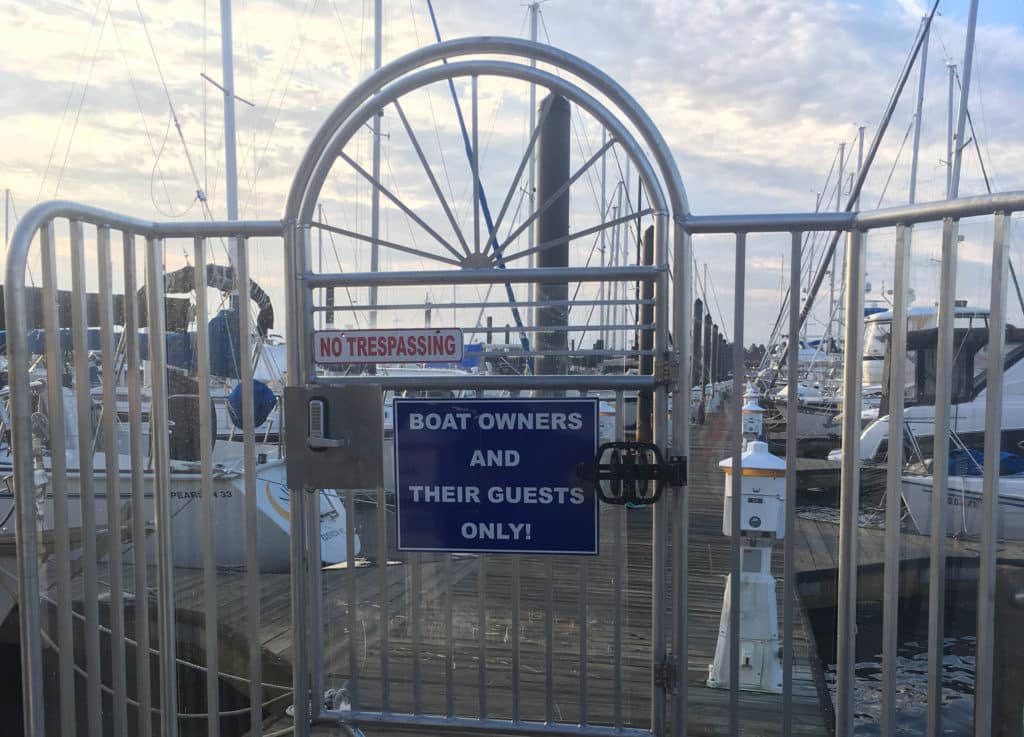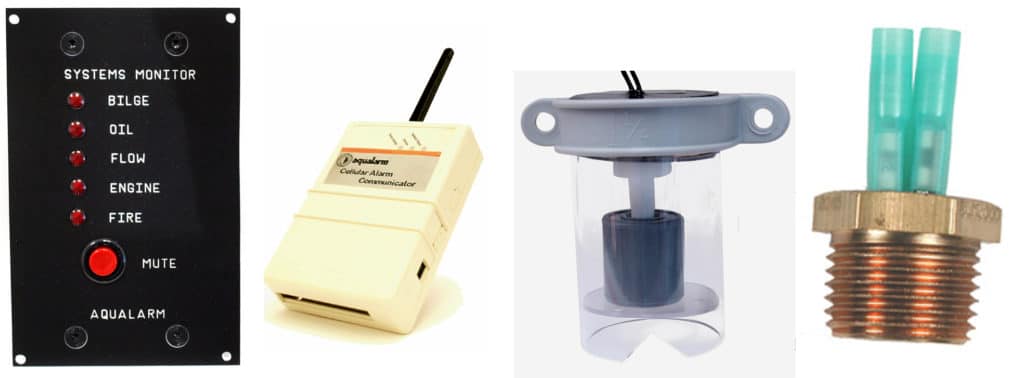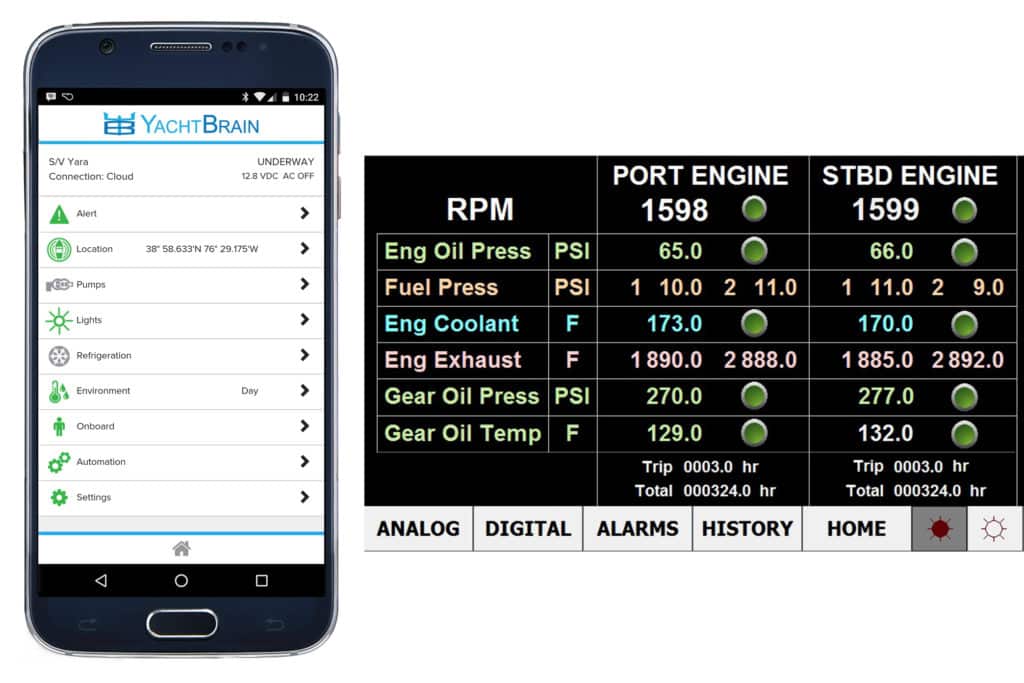
Sailing lore is rife with colorful yarns, but one of the all-time classics belongs to Joshua Slocum, the Nova Scotia-born American sailor and writer who was the first person to circumnavigate singlehandedly. In Slocum’s legendary account of his adventures, Sailing Alone Around the World, he recounts an incident when Spray attracted the unwanted interests of unsavory locals one evening while anchored near Thieves Bay, en route to the Strait of Magellan. Slocum wisely scattered upturned carpet tacks on his decks before retiring to his berth. “I had no need of a dog,” he wrote of his uninvited guests’ reaction. “They howled like a pack of hounds.”
The ruse worked, the thieves scattered, and Slocum and Spray continued sailing. While this tale of preparation trumping thievery has a humorous outcome, it hits on several key factors that still hold true in 2017. A good security system employs careful planning, superior technology, and subterfuge to induce fear and confusion among any unwanted visitors. Moreover, like Slocum’s tacks, a proper security system gives those on board the tools and time to react to any threat. Sailboats, after all, are high-dollar investments and will always be tempting targets for thieves. To protect them, modern security and vessel-monitoring systems use stealthy sensors, cellular modems and geofences, among other surprises, to thwart intruders, while also allowing an owner to monitor and control different onboard systems and devices from afar. Here’s a look at how this technology works and how it can make your vessel safer from theft and systems-related trouble while delivering peace of mind.
The best vessel alarms are those that are hard to detect and involve multiple stages of escalation. “Security is like an onion,” says Jay Keenan, president and CEO of Global Ocean Security Technologies, or GOST. “The more layers there are, and the more independent each layer is, the more secure the asset becomes.” Because of this, contemporary security systems use combinations of obvious and hidden devices such as deck-pressure sensors, infrared beams, door and hatch sensors, motion detectors, and IP-enabled cameras, as well as lights and sirens, all of which can be monitored and controlled from a smartphone, tablet or computer. These sensors and detectors report to a central-processing unit, or CPU, which is typically a black box that’s equipped with a cellular modem or a Wi-Fi card, giving it the ability to communicate with the outside world.
Most security and vessel-monitoring systems are designed to be expandable, allowing owners to add sensors and vessel-specific solutions as needed.
“Reduction of false alarms is critical,” says Keenan. GOST’s video extraction algorithms, which work at low data rates over cellular and satellite-communication networks, are extremely advanced, for instance. “We have many sailing clients with mast cams who, when the system is armed, receive a video-clip alert if anyone pulls into their yacht’s perimeter on anchor.”
Most modern security and vessel-monitoring systems, in fact, can be configured to contact an owner, marina, harbormaster or police in the case of unwanted activity by sending an email or text message, or even make a phone call.
If this sounds like a home-security system, you’re on the right track — but with a key difference. Should an alarm trip, most vessel-security systems do not contact a monitoring center, where a worker calls the owner and the police. Instead, these systems execute a call themselves based on a set of rules and parameters that are either bundled into their operating systems or determined by their owners.

Proactive Security, Monitoring
While most criminals are quickly scattered by the sound of an alarm, the obstinate few press forward, perhaps thinking that they can defeat the system or that time is on their side, especially if valuables and electronics can be easily snatched. Should that happen, robust systems can create highly unpleasant working conditions for the thief.
“We make acoustic devices that, at a close range, create an unbearable frequency pattern,” says Keenan. “It’s not loud, but the intruder will experience vertigo.” Should the intruder break into the saloon, for example, devices such as GOST’s Cloak emit a vaporized glycol solution that fills the cabin with a thick, disorienting fog that makes it almost impossible for a thief to see or, sometimes, even escape.
Critically, yacht-security systems should be able to be deactivated only by the owner and never by a burglar. This is accomplished by using app- and website-based user interfaces to control the system, as well as hidden hardware and reserve batteries, should a mainline power supply or the system’s CPU get compromised.
While vessel-security systems have historically represented the bulk of the remote-monitoring market, this is changing, says Keith Cariani, director of business development at Aydin Marine (née KEP). The vast majority of inquiries that Aydin gets these days are from customers interested in vessel monitoring.
In addition to Aydin’s Seatether, players in the monitoring arena include companies like Yacht Protector, Siren Marine’s Pixie, Scribble Software’s MyBoatStatus and Aqualarm’s various sensors. These companies still offer vessel-security elements such as geofencing, door sensors and pressure mats, but their systems are more oriented toward monitoring metrics such as bilge-water levels, the frequency that the bilge pumps are running, batteries and shore-power supply, as well as fire, smoke, temperature and humidity levels.
Like security alarms, most vessel-monitoring systems consist of a CPU and a network of wired or wireless sensors that can be set to monitor and control a bevy of onboard devices, ranging from masthead lights to bilge pumps. This is typically accomplished using relay switches that can power devices and systems on or off, and which are controlled via the CPU and apps that run on a smartphone or tablet.
Other systems, such as YachtBrain — which was launched at the 2016 U.S. Sailboat Show in Annapolis, Maryland, and which is expected to be available in 2017 — focus on vessel monitoring, control and automation. According to Allen Beckerdite, YachtBrain’s co-founder, the system uses wireless sensors and relays that are programmed to owner-defined rules and alerts, and take action when conditions warrant. The system might, for instance, blare an onboard horn if the high-water alarm is triggered or send an owner an alert.

YachtBrain’s basic system can sense up to four electrical devices, and users can define alerts for events such as a bilge pump cycling three times in 10 seconds or, conversely, to report a pump that has not run in 30 days, which could mean it needs maintenance, says Beckerdite. YachtBrain is expandable by simply adding more sensors and relays. Unlike most other vessel-monitoring systems, YachtBrain doesn’t simply send an email or text message to notify owners about status updates or alarms.
“YachtBrain uses a reliable connection protocol that is designed to operate over unreliable network connections,” says Beckerdite. “These protocols were designed for industrial use and are now being used for the Internet of Things.” For remote access, most systems rely on a built-in cellular modem, a Wi-Fi card or satellite capability. Controls are via an app or secure Web page, allowing owners to log in to the networked systems from anywhere, provided that the vessel can communicate with the Internet.
YachtBrain, says Beckerdite, takes things a step further. In addition to its built-in Wi-Fi card, if no Internet connection is available, the system’s CPU can make decisions on its own, based on rules the owner has established, and then report the actions taken once connectivity is restored.
Provided that connectivity exists, modern vessel-monitoring systems provide peace of mind, especially when owners are away from their boats. Here, however, systems need to strike the right balance of keeping an owner informed without generating and sending large, expensive amounts of data.
“The data bursts are really small, and our sensors run off internal batteries,” says Vance Young, the director of technology at Scribble Software. “Our entire system uses less than a megabyte of data all month.” Young notes that constant sensing (i.e., motion sensors) uses more data than ones that report on longer-interval schedules (i.e., high-water sensors), so an owner can tailor data usage to acceptable comfort levels through a choice of hardware.
“Alerts depend on how you configure your system,” advises Cariani, who stresses the importance of avoiding false alarms. “We want it to work, but we don’t want it to be a burden. Owners don’t want a warning over something that’s not a real issue.”
Finally, most vessel-security and -monitoring systems are also designed to help recover a boat in the event it’s been stolen. Fortunately for sailors, thieves tend to be more interested in powerboats, but sailboats do disappear, and unlike powerboats, are capable of operating for prolonged periods without refueling. Because of this, products such as GOST’s Phantom Insight or Nav-Tracker use hidden tracking antennas with self-contained, two-way Inmarsat satellite modems and GPS receivers that notify their owners or other owner-designated parties if the alarm trips or if the vessel breaches its owner-defined geofence. These systems continually send their position information to a secure server, allowing the vessel to be tracked in real-time, even if the thieves destroy the CPU or start indiscriminately ripping wires from the panel.
While yacht-security and vessel-monitoring systems can be expensive — they can range from a few hundred to several thousands of dollars — and require proper planning, technology and connectivity, they are a wise investment for anyone who keeps their boat in a high-crime area or doesn’t live close enough to regularly check on its status and systems. Provided that the proper level of technology is applied in tandem with the right amount of subterfuge and surprise, these systems provide a ton of security and reassurance, without requiring you to scatter carpet tacks on deck before finding your bunk.
David Schmidt is Cruising World’s electronics editor.








